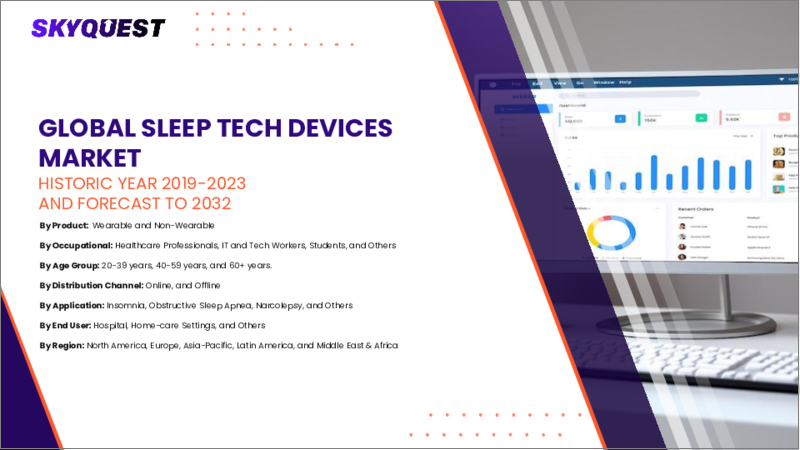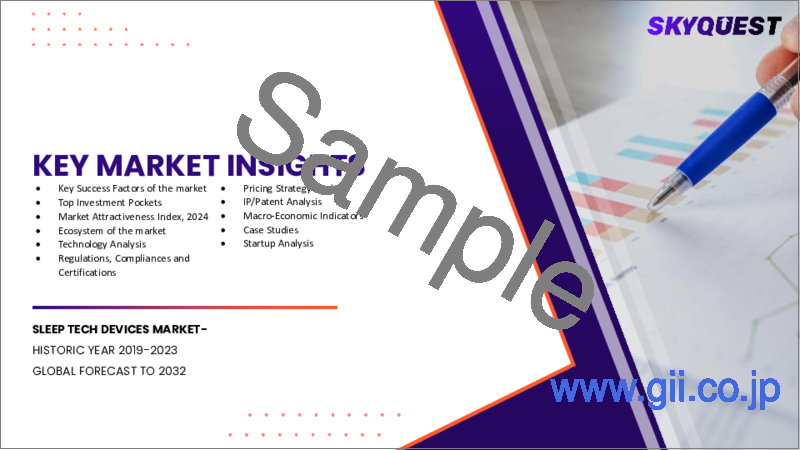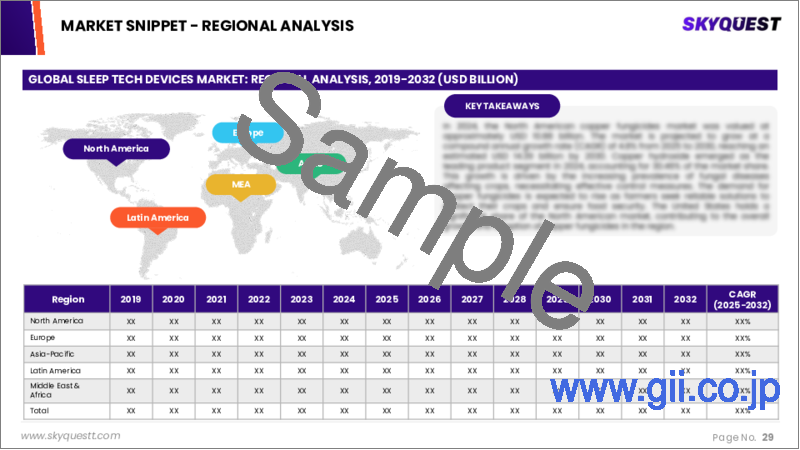|
|
市場調査レポート
商品コード
1619052
スリープテックデバイス市場規模、シェア、成長分析、製品別、職業別、年齢層別、用途別、エンドユーザー別、流通チャネル別、地域別 - 産業予測、2024~2031年Sleep Tech Devices Market Size, Share, Growth Analysis, By Product, By Occupational, By Age Group, By Application, By End User, By Distribution Channel, By Region - Industry Forecast 2024-2031 |
||||||
|
|||||||
| スリープテックデバイス市場規模、シェア、成長分析、製品別、職業別、年齢層別、用途別、エンドユーザー別、流通チャネル別、地域別 - 産業予測、2024~2031年 |
|
出版日: 2024年12月20日
発行: SkyQuest
ページ情報: 英文 157 Pages
納期: 3~5営業日
|
全表示
- 概要
- 目次
スリープテックデバイスの世界市場規模は、2022年に約190億8,000万米ドルと評価され、2023年の225億3,000万米ドルから上昇し、予測期間(2024~2031年)のCAGRは18.31%で、2031年には862億5,000万米ドルに達すると予測されます。
世界のスリープテックデバイス市場は、著しい技術進歩とともに、不眠症や睡眠時無呼吸症候群などの睡眠障害の増加によって、急速な拡大を目の当たりにしています。主要企業はAI、ML、IoTを取り入れて、睡眠問題の個別診断を提供する革新的な製品を開発しています。腕時計、フィットネストラッカー、スマート寝具のようなスマート・ウェアラブルの需要の増加は、ユーザーの睡眠サイクルを効果的にモニターする能力を強化することにより、市場の成長をさらに促進しています。スマートフォンとの相乗効果により、利便性と普及率が高まっています。さらに、健康ソリューションに対する世界の意識の高まりもこの動向を後押ししています。当社の分析によると、特許出願件数は2013年の19,635件から2023年には68,873件へと劇的に増加しており、研究開発活動が活発であることを示しています。北米が最大の市場であり、CAGR 18%という驚異的な成長が予測されています。
目次
イントロダクション
- 調査の目的
- 定義
- 市場範囲
調査手法
- 情報調達
- 二次データソースと一次データソース
- 市場規模予測
- 市場の前提条件と制限
エグゼクティブサマリー
- 市場概要見通し
- 供給需要動向分析
- セグメント別機会分析
市場力学と見通し
- 市場力学
- 促進要因
- 機会
- 抑制要因
- 課題
- ポーターの分析
主な市場の考察
- 技術分析
- 特許分析
- 規制情勢
- 重要成功要因
- スタートアップ分析
- 市場の魅力指数
- 競合の程度
- 主な投資機会
- エコシステムマッピング
スリープテックデバイス市場:製品別
- 市場概要
- ウェアラブル
- スマートウォッチとバンド
- その他
- 非ウェアラブル
- 睡眠モニター
- スマートベッド
- その他
スリープテックデバイス市場:職業別
- 市場概要
- ヘルスケア従事者
- ITおよび技術労働者
- 学生
- その他
スリープテックデバイス市場:年齢層別
- 市場概要
- 20~39歳
- 40~59歳
- 60歳以上
スリープテックデバイス市場:用途別
- 市場概要
- 不眠症
- 閉塞性睡眠時無呼吸
- ナルコレプシー
- その他
スリープテックデバイス市場:エンドユーザー別
- 市場概要
- 病院
- 在宅ケアの設定
- その他
スリープテックデバイス市場:流通チャネル別
- 市場概要
- オンラインチャンネル
- オフラインチャンネル
スリープテックデバイス市場規模:地域別
- 市場概要
- 北米
- 米国
- カナダ
- 欧州
- ドイツ
- スペイン
- フランス
- 英国
- イタリア
- その他欧州地域
- アジア太平洋地域
- 中国
- インド
- 日本
- 韓国
- その他アジア太平洋地域
- ラテンアメリカ
- ブラジル
- その他ラテンアメリカ地域
- 中東・アフリカ(MEA)
- GCC諸国
- 南アフリカ
- その他中東・アフリカ地域
競合情勢
- 上位5社の比較
- 主要企業の市場ポジショニング(2023年)
- 主な市場企業が採用した戦略
- 市場における最近の活動
- 主要企業の市場シェア(2023年)
主要企業プロファイル
- SLEEP NUMBER CORPORATION
- RESMED
- FISHER & PAYKEL
- SLEEPACE
- SIMBA SLEEP LIMITED
- REM-FIT
- XIAOMI
- EMFIT LTD
- EIGHT SLEEP INC
- BEACON BIOSIGNALS, INC
- OURA HEALTH OY
- APPLE INC
- SAMSUNG
- KONINKLIJKE PHILIPS N.V.
- FITBIT INC
- GARMIN LTD
- WITHINGS
- APOLLO NEUROSCIENCE, INC
- COMPUMEDICS LIMITED
- SLEEP SHEPHERD LLC
結論と推奨事項
Global Sleep Tech Devices Market size was valued at around USD 19.08 billion in 2022 and is expected to rise from USD 22.53 billion in 2023 to reach a value of USD 86.25 Billion by 2031, at a CAGR of 18.31% over the forecast period (2024-2031).
The global sleep tech devices market is witnessing rapid expansion, fueled by rising sleep disorders such as insomnia and sleep apnea, alongside significant technological advancements. Leading companies are incorporating AI, ML, and IoT to create innovative products that offer personalized diagnostics for sleep issues. The increasing demand for smart wearables-like watches, fitness trackers, and smart bedding-further propels market growth by enhancing users' ability to monitor sleep cycles effectively. This synergy with smartphones boosts convenience and adoption rates. Additionally, heightened global awareness of health solutions supports this trend. Our analysis shows a dramatic increase in patent applications from 19,635 in 2013 to 68,873 in 2023, indicating robust R&D activity. North America stands as the largest market, projected to grow at an impressive 18% CAGR.
Top-down and bottom-up approaches were used to estimate and validate the size of the Global Sleep Tech Devices market and to estimate the size of various other dependent submarkets. The research methodology used to estimate the market size includes the following details: The key players in the market were identified through secondary research, and their market shares in the respective regions were determined through primary and secondary research. This entire procedure includes the study of the annual and financial reports of the top market players and extensive interviews for key insights from industry leaders such as CEOs, VPs, directors, and marketing executives. All percentage shares split, and breakdowns were determined using secondary sources and verified through Primary sources. All possible parameters that affect the markets covered in this research study have been accounted for, viewed in extensive detail, verified through primary research, and analyzed to get the final quantitative and qualitative data.
Global Sleep Tech Devices Market Segmental Analysis
The global sleep tech devices market is segmented based on product, occupational, age group, application, end user, distribution channel, and region. Based on product, the market is segmented into Wearable (Smart Watches& Bands, and Others), and Non-Wearable (Sleep monitors, Beds, and Others). Based on occupational, the market is segmented into Healthcare Professionals, IT & Tech Workers, Students, and Others. Based on age group, the market is segment into 20-39 years, 40-59 years, and 60+ years. Based on application, the market is segmented into Insomnia, Obstructive Sleep Apnea, Narcolepsy, and Others. Based on end user, the market is segmented into hospital, home-care settings, and others. Based on distribution channel, the market is segmented into online channel, and offline channel. Based on region, the market is segmented into North America, Europe, Asia Pacific, Latin America, and Middle East & Africa.
Driver of the Global Sleep Tech Devices Market
The Global Sleep Tech Devices market is primarily driven by the rising incidence of sleep disorders, which has heightened the demand for both wearable and non-wearable sleep technology, as well as sleep tracking applications. Our thorough analysis indicates that sleep disorders are becoming recognized as a significant global issue, particularly in developed countries like the United States. According to a survey by the American Academy of Sleep Medicine (AASM), around 30% of adults experience symptoms of insomnia, characterized by difficulties in falling or staying asleep. Although persistent insomnia, lasting for months or years, affects less than 10% of adults, it remains a chronic challenge for those impacted. Consequently, the growing number of individuals suffering from sleep disorders is significantly fueling the demand for sleep tech devices.
Restraints in the Global Sleep Tech Devices Market
One significant barrier to the growth of the Global Sleep Tech Devices market is the high cost associated with advanced sleep technology products. Items such as smart mattresses, sleep trackers, and various sleep aid devices are generally priced higher than traditional sleep solutions, limiting their accessibility to a broader consumer base, particularly in developing regions where average incomes are lower. The combination of the initial purchase price and potential ongoing subscription fees for related applications further exacerbates this issue, making it unaffordable for many potential users. Consequently, this economic constraint restricts market growth, as primarily affluent consumers can afford these innovations, leading to slower market development and saturation.
Market Trends of the Global Sleep Tech Devices Market
The Global Sleep Tech Devices market is increasingly shaped by the integration of artificial intelligence (AI) and machine learning (ML), which serve as pivotal trends driving innovation. This collaboration enhances the precision and personalization of sleep assessments, enabling devices to learn from user data to identify patterns and provide tailored recommendations for improved sleep quality. AI algorithms can forecast potential sleep disorders and suggest appropriate interventions, while adaptive ML systems adjust environmental factors like light and temperature to optimize sleep conditions. Heightened demand for personalized health solutions, along with advancements in affordable, high-quality sensors, is fueling this trend, promising significant developments in sleep technology as it continues to evolve.
Table of Contents
Introduction
- Objectives of the Study
- Definitions
- Market Scope
Research Methodology
- Information Procurement
- Secondary & Primary Data Sources
- Market Size Estimation
- Market Assumptions & Limitations
Executive Summary
- Market Overview Outlook
- Supply Demand Trend Analysis
- Segmental Opportunity Analysis
Market Dynamics & Outlook
- Market Dynamics
- Drivers
- Opportunities
- Restraints
- Challenges
- Porters Analysis
- Competitive rivalry
- Threat of Substitute Products
- Bargaining Power of Buyers
- Threat of New Entrants
- Bargaining Power of Suppliers
Key Market Insights
- Technology Analysis
- Patent Analysis
- Regulatory Landscape
- Key Success Factors
- Startup Analysis
- Market Attractiveness Index
- Degree of Competition
- Top Investment Pockets
- Ecosystem Mapping
Sleep Tech Devices Market by Product
- Market Overview
- Wearable
- Smart Watches & Bands
- Others
- Non-Wearable
- Sleep Monitors
- Smart Beds
- Others
Sleep Tech Devices Market by Occupational
- Market Overview
- Healthcare Professionals
- IT & Tech Workers
- Students
- Others
Sleep Tech Devices Market by Age-Group
- Market Overview
- 20-39 years
- 40-59 years
- 60+ years
Sleep Tech Devices Market by Application
- Market Overview
- Insomnia
- Obstructive Sleep Apnea
- Narcolepsy
- Others
Sleep Tech Devices Market by End User
- Market Overview
- Hospital
- Home-care Settings
- Others
Sleep Tech Devices Market by Distribution Channel
- Market Overview
- Online Channel
- Offline Channel
Sleep Tech Devices Market Size by Region
- Market Overview
- North America
- USA
- Canada
- Europe
- Germany
- Spain
- France
- UK
- Italy
- Rest of Europe
- Asia Pacific
- China
- India
- Japan
- South Korea
- Rest of Asia-Pacific
- Latin America
- Brazil
- Rest of Latin America
- Middle East & Africa (MEA)
- GCC Countries
- South Africa
- Rest of MEA
Competitive Landscape
- Top 5 Player Comparison
- Market Positioning of Key Players, 2023
- Strategies Adopted by Key Market Players
- Recent Activities in the Market
- Key Companies Market Share (%), 2023
Key Company Profiles
- SLEEP NUMBER CORPORATION
- Company Overview
- Business Segment Overview
- Financial Updates
- Key Developments
- RESMED
- Company Overview
- Business Segment Overview
- Financial Updates
- Key Developments
- FISHER & PAYKEL
- Company Overview
- Business Segment Overview
- Financial Updates
- Key Developments
- SLEEPACE
- Company Overview
- Business Segment Overview
- Financial Updates
- Key Developments
- SIMBA SLEEP LIMITED
- Company Overview
- Business Segment Overview
- Financial Updates
- Key Developments
- REM-FIT
- Company Overview
- Business Segment Overview
- Financial Updates
- Key Developments
- XIAOMI
- Company Overview
- Business Segment Overview
- Financial Updates
- Key Developments
- EMFIT LTD
- Company Overview
- Business Segment Overview
- Financial Updates
- Key Developments
- EIGHT SLEEP INC
- Company Overview
- Business Segment Overview
- Financial Updates
- Key Developments
- BEACON BIOSIGNALS, INC
- Company Overview
- Business Segment Overview
- Financial Updates
- Key Developments
- OURA HEALTH OY
- Company Overview
- Business Segment Overview
- Financial Updates
- Key Developments
- APPLE INC
- Company Overview
- Business Segment Overview
- Financial Updates
- Key Developments
- SAMSUNG
- Company Overview
- Business Segment Overview
- Financial Updates
- Key Developments
- KONINKLIJKE PHILIPS N.V.
- Company Overview
- Business Segment Overview
- Financial Updates
- Key Developments
- FITBIT INC
- Company Overview
- Business Segment Overview
- Financial Updates
- Key Developments
- GARMIN LTD
- Company Overview
- Business Segment Overview
- Financial Updates
- Key Developments
- WITHINGS
- Company Overview
- Business Segment Overview
- Financial Updates
- Key Developments
- APOLLO NEUROSCIENCE, INC
- Company Overview
- Business Segment Overview
- Financial Updates
- Key Developments
- COMPUMEDICS LIMITED
- Company Overview
- Business Segment Overview
- Financial Updates
- Key Developments
- SLEEP SHEPHERD LLC
- Company Overview
- Business Segment Overview
- Financial Updates
- Key Developments






